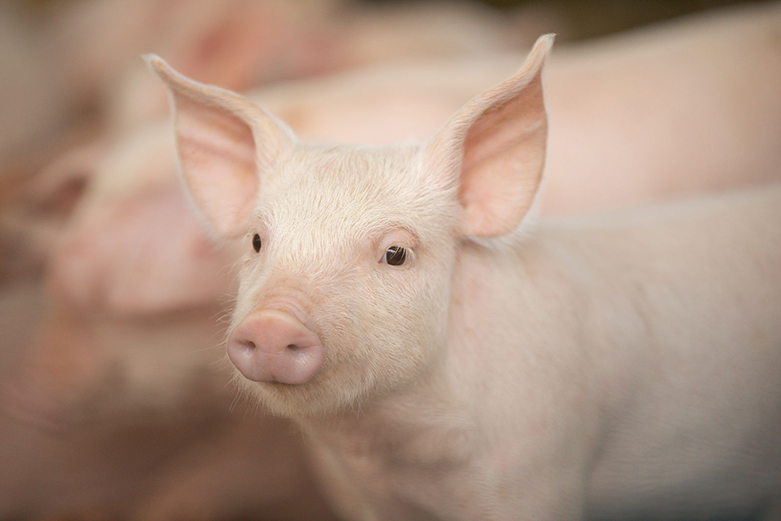Published on The Pig Site
At PIC, the genetic improvement of pigs is accelerating faster than ever before.
It’s about continually building our understanding of pig genetics and using this knowledge to improve the products we offer – all to help our customers achieve greater profitability.
We continue to achieve genetic improvement on every breeding front, from litter size and piglet survival, to feed efficiency, better growth rates and better pork quality.
Take a quick look at these top pork quality game-changers in the PIC Genetic Improvement Program – historic, current and what’s coming down the pipeline:
Pork Quality game changer – understanding muscle biology
When living muscle becomes meat complex metabolic, physiological and structural alterations occur. In 1994, De Vries et al. established that carcass handling, as well as animal handling on farm, during transport and before slaughter, has a profound effect on pork quality.
In 1996, PIC presented a comprehensive outline of these handling factors in our initial Pork Quality Blueprint.
Pork quality game changer – Selection for ultimate pH
In 1998, we began selecting Ultimate pH (pHu) as a driver of pork quality and eating satisfaction. This measure is highly correlated with meat color, processing characteristics, and eating satisfaction.
“Data on pHu is used to compute the Estimated Breeding Values that are included in PIC genetic indices, which influences the selection of every PIC pig,” explains PIC geneticist William Herring. “Today, we measure pHu on more than 25,000 pedigreed carcasses annually to ensure PIC continues to offer the pork industry great eating satisfaction across all of our products.”
Pork quality game changer – GNX program
Because PIC is focused on maximizing the profit potential of commercial market pigs, we implemented the Genetic Nucleus Crossbred program (GNX-bred program). Since 2003, the GNX-bred program has captured data from commercial environments to improve the accuracy of selection decisions made in PIC’s genetic farms for traits such as robustness, growth rate, efficiency, and carcass value – including pork quality traits. Every week, carcass traits ranging from primal yields to pHu, color, and marbling are measured on thousands of pedigreed commercial pigs.
Pork quality game changer – Selection in intramuscular fat (IMF) using ultrasound
Starting in 2007, we began to select for IMF in our PIC Duroc (PIC280), enabling us to hone our breeding program to optimize this trait. While some market segments seek a higher IMF value, others do not. For customers wishing to deliver higher marbled pork into a premium market whilst not losing in terms of overall profitability, the PIC280 is a great option.
Pork quality game changer – Inclusion of lactate analysis
In 2009, we added the analysis of lactic acid to our breeding program. Lactic acid is measured through our proprietary ‘fitness test,’ during which pigs partake in mild exercise, after which blood samples are tested for lactic acid. Pigs with lower lactate levels after the exercise are more robust and thus cope better with environmental stressors. Stress-susceptible pigs are more prone to transport losses and becoming non-ambulatory. Stress-susceptible pigs are also more prone to inferior pork quality because of the lactic acid buildup in the muscles before slaughter and early post-coma, resulting in lower pH. Therefore, PIC selects those animals with the lowest lactate levels post-exercise in order to maximize robustness and pork quality.
Pork quality game changer – Use of new technologies
Our strong and continual investment in R&D ensures PIC remains highly active in creating and adopting new technologies and methodologies such as data capture, trait development, genomic evaluation, and genome sequencing.
For example, in 2012, we began to employ our proprietary ‘relationship-based genomic selection platform.’ This system grants our scientists the power to understand DNA relationships between animals and increased accuracy of selection for all traits, including pork quality, in our indexes. Overall, it has allowed us to increase our rate of genetic improvement by over 35%, helping us deliver the highest rates of genetic gain PIC has ever achieved in our 55-year history.
Future pork quality game-changer in the pipeline – New measure of eating satisfaction
PIC is starting a new program involving a direct measures of consumer eating satisfaction. Watch for upcoming articles in our Pig Improver newsletter for an inside look at this exciting initiative.
As you can see, PIC’s genetic improvement program continues to ‘up its game,’ building on what we have already achieved. Our future – and yours – has never looked so bright, as we continue to deliver on our promise to Never Stop Improving.






